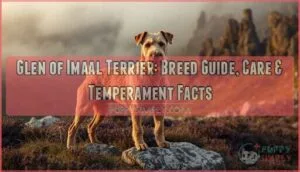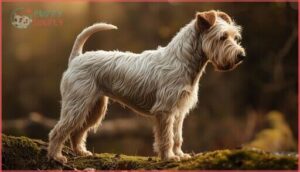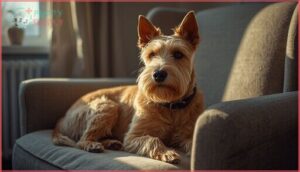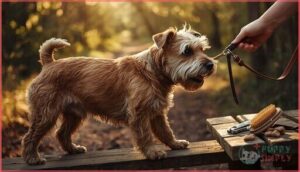This site is supported by our readers. We may earn a commission, at no cost to you, if you purchase through links.

Most terrier breeds announce themselves with sharp barks and restless energy, but the Glen of Imaal Terrier earned its reputation through quiet determination in Ireland’s rocky highlands. This breed spent centuries hunting badgers and foxes in the harsh terrain of County Wicklow’s Glen of Imaal, where survival demanded strength packed into a compact frame.
Unlike their high-strung terrier cousins, Glens developed a calm, stoic temperament that modern families find surprisingly easy to live with. Their muscular build, weatherproof double coat, and trademark bowed front legs tell the story of dogs bred for function over fashion.
Understanding what makes this rare breed different starts with recognizing they’re working terriers who happen to make excellent companions, not lap dogs pretending to be tough.
Table Of Contents
- Key Takeaways
- Glen of Imaal Terrier Origins and History
- Physical Characteristics of The Glen of Imaal Terrier
- Temperament and Behavior Traits
- Health, Nutrition, and Lifespan
- Care, Training, and Exercise Needs
- Frequently Asked Questions (FAQs)
- What is the average lifespan of a Glen of Imaal Terrier?
- Are Glen of Imaal Terriers good with other pets?
- Are Glen of Imaal Terriers prone to separation anxiety?
- What are some common training challenges with Glen of Imaal Terriers?
- Are Glen of Imaal Terriers good apartment dogs?
- How much does a Glen of Imaal Terrier cost?
- Do Glen of Imaal Terriers bark a lot?
- Can Glen of Imaal Terriers be left alone?
- Are Glen of Imaal Terriers hypoallergenic or shed heavily?
- Conclusion
Key Takeaways
- The Glen of Imaal Terrier stands apart from typical terriers with a calm, stoic temperament that makes them surprisingly easy to live with, barking only when necessary rather than constantly announcing themselves.
- This breed’s distinctive physical build—bowed front legs, muscular frame, and weatherproof double coat—reflects centuries of practical work hunting badgers and foxes in Ireland’s harsh terrain, not a focus on appearance.
- While they’re generally healthy dogs living 10-15 years, you’ll need to watch for breed-specific issues like Progressive Retinal Atrophy, hip dysplasia, and skin allergies through regular genetic screening and vet care.
- Their independent nature and strong prey drive require patient, consistent training with positive reinforcement starting during the critical 3-14 week socialization window, especially if you have other pets or small children at home.
Glen of Imaal Terrier Origins and History
The Glen of Imaal Terrier has roots that stretch back centuries to the rugged mountains of Ireland. This breed wasn’t created for show—it was built for hard work in tough terrain.
Understanding where this terrier came from helps explain the sturdy, determined dog you’ll meet today.
Development in Ireland’s Glen of Imaal
During the 1600s, the Glen of Imaal Terrier emerged in County Wicklow’s remote Glen of Imaal, Ireland. The breed history traces back to crossbreeding between native Irish terriers and small hounds brought by mercenaries:
- Dogs with bowed legs suited for badger hunting appeared in writings as early as 1575
- Environmental influence from rugged terrain shaped the breed’s hardy nature
- Modern preservation efforts prevented extinction in the early 20th century
This dog breed origin reflects Ireland’s practical farming needs. The breed gained recognition when the Irish Kennel Club recognized it in 1934.
Early Roles as a Working Terrier
After establishing themselves in Ireland’s countryside, these working terriers took on demanding farm duties. Their roles were split between vermin control and specialized tasks that shaped their unique build.
| Primary Role | Key Tasks |
|---|---|
| Vermin Control | Hunting rats, foxes, badgers, and mink to protect livestock |
| Farm Guardianship | Monitoring sheep and cattle while deterring predators |
| Turnspit Function | Running treadmills to turn meat over kitchen fires |
Their quiet temperament set them apart from typical terriers—these dogs hunted silently, entering dens without barking. As a recognized breed, they’re known as a working terrier that’s gentler than most. This prey drive made Glen of Imaal Terrier breeds particularly adept at earthdog activities, where they’d track game underground until the job was done.
Recognition by Kennel Clubs
As their farm work proved their worth, dog breed clubs began to take notice. You’ll find the Glen of Imaal Terrier received recognition from major organizations over several decades:
- Irish Kennel Club welcomed them in 1934 as the third native Irish terrier
- England’s Kennel Club granted breed standards in 1975
- AKC entry came in 2004, expanding show participation
- FCI recognition in 2024 strengthened their international pedigree
This recognition ensured breed preservation efforts would continue.
Physical Characteristics of The Glen of Imaal Terrier
The Glen of Imaal Terrier has a sturdy, compact build that sets it apart from other terrier breeds. You’ll notice its powerful frame and distinctive coat right away.
Let’s look at the specific physical traits that make this breed unique.
Size, Weight, and Build
You’ll notice the Glen of Imaal Terrier’s stocky, powerful frame right away. This working dog stands 12.5 to 14 inches tall at the shoulder and weighs 30 to 40 pounds, creating ideal proportions for its historic role.
The muscular build features a broad chest and slightly bowed front legs—distinctive breed standards that set it apart. Its body is longer than tall, with a unique 3:5 height-to-length ratio reflecting true breed characteristics.
Coat Types and Colors
The Glen of Imaal Terrier’s double coat features a wiry outer layer with a soft undercoat. Coat genetics create this distinctive texture, offering weather protection and requiring regular texture maintenance.
You’ll find color variations including:
- Wheaten shades from cream to red
- Blue tones ranging from gray to bluish hues
- Brindle patterns with muted stripes
- Mixed combinations of these colors
- Black noses across all coat colors
Understanding coat development and grooming needs helps maintain this breed’s characteristic appearance.
Distinctive Features
You’ll recognize this breed by its bowed legs and broad head shape—features that set it apart from other terriers. The wiry coat covers a low-slung, rectangular body with unique proportions longer than tall.
Watch how the dog breed’s physical traits create a distinctive rolling gait. Front feet turn outward slightly, while the muscular build reveals its working heritage.
Temperament and Behavior Traits
The Glen of Imaal Terrier has a temperament that sets it apart from other terrier breeds. You’ll find this dog to be calmer and more easygoing than many of its high-strung cousins, though it still carries that classic terrier spirit.
Let’s look at the key behavior traits that make this breed unique.
Personality and Family Suitability
Glen of Imaal Terriers make excellent family companions, blending gentle loyalty with steady calm. Their stoic temperament and preference for physical closeness create strong bonds with owners. Despite their independence, Glens demonstrate trustworthiness and patience, adapting well to various home environments from apartments to houses. Their laid-back demeanor balances perfectly with bursts of playful energy when engaged.
Glen of Imaal Terriers blend gentle loyalty with calm independence, forming deep bonds while adapting to any home with playful bursts of energy
What makes this breed special for families:
- Affection levels run deep—they’ll follow you room to room, preferring your company over solitude
- Companion suitability shines through their desire to please and problem-solving intelligence
- Dog breed temperament remains remarkably even-keeled, barking only when truly necessary
- Home environment flexibility means they thrive anywhere with consistent mental stimulation
- Socialization importance can’t be overstated—early exposure ensures comfort with various household dynamics
Interaction With Children and Pets
You’ll want to know how this breed fits into your household before bringing one home. Child supervision remains essential—Glens love kids, but their strength can accidentally overwhelm toddlers. Pet introduction requires patience, as their hunting instincts may trigger chasing behavior toward smaller animals. Early socialization shapes breed temperament positively, teaching safe play boundaries that benefit family dynamics.
Proper training from puppyhood ensures your Glen understands household limits. Dog breed family life thrives when everyone respects the dog’s independent nature while encouraging positive reinforcement. This dog temperament responds beautifully to consistency—puppies especially benefit from structured exposure to various family situations, building confidence that lasts throughout their lives.
| Interaction Type | Compatibility Level | Key Considerations |
|---|---|---|
| Older Children | Excellent | Gentle handling required |
| Young Toddlers | Moderate | Constant adult oversight |
| Other Dogs | Good | Early socialization vital |
| Small Pets | Cautious | Monitor prey drive |
| Multi-Pet Homes | Variable | Raised-together works best |
Typical Energy Levels
Unlike high-octane terriers, your Glen won’t bounce off the walls. This breed ranks 3 out of 5 for energy, needing 30 to 90 minutes of daily exercise—think brisk morning walks and evening wind-downs. Puppy activity should stay gentle until growth plates close around 9 to 12 months.
Weekly routine variety keeps them sharp: adventure days, scent work, and trail hikes. Energy factors like age and health shape individual dog exercise needs.
Health, Nutrition, and Lifespan
Glen of Imaal Terriers are generally healthy dogs, but like any breed, they can face certain health issues you should be aware of.
Proper nutrition plays a big role in keeping your Glen in good shape throughout their life.
Let’s look at the health concerns to watch for, what to feed your dog, and what you can expect regarding lifespan.
Common Health Concerns
While Glen of Imaal Terriers are generally healthy, you should be aware of several health problems. Progressive Retinal Atrophy (PRA) and Degenerative Myelopathy (DM) are significant genetic dog health issues requiring genetic screening. Joint dysplasia affects roughly 30% of the breed, causing arthritis over time. Skin allergies are also common.
Genetic testing and preventative care help responsible breeders reduce these dog breed health issues effectively.
Recommended Diet and Nutrition
Beyond managing health concerns, proper nutrition forms the foundation of your Glen of Imaal Terrier’s well-being. High-quality protein sources like beef, chicken, and fish support muscle health and disease prevention.
Feed your dog twice daily with portions matched to their activity level. Fresh, minimally processed food quality matters more than quantity.
Don’t overlook hydration needs—moisture-rich diets help maintain their body’s 70% water composition naturally.
Expected Lifespan and Wellness
With proper care, your Glen of Imaal Terrier can live 10 to 15 years, sometimes reaching 18. Their life span depends on preventative care like regular vet visits, managing genetic predispositions such as hip dysplasia, and environmental enrichment through mental stimulation.
Exercise impact matters too—daily activity strengthens their heart and maintains a healthy weight. Comparative data shows responsible breeding and attention to common health problems greatly extend dog breed health and care outcomes.
Care, Training, and Exercise Needs
Glen of Imaal Terriers are low-maintenance dogs, but they do need regular care to stay healthy and happy. Their exercise needs are moderate compared to other terriers, and they respond well to patient, consistent training.
Let’s look at the grooming, activity, and training approaches that work best for this breed.
Grooming Requirements
Your Glen of Imaal Terrier’s grooming needs center on maintaining that distinctive double coat. Brush two to three times weekly to prevent matting, while hand-stripping removes dead hair twice yearly.
Bathing frequency stays minimal—just three to four times annually.
Don’t overlook nail trimming every few weeks, regular ear cleaning, and dental hygiene to keep your terrier healthy and comfortable.
Exercise and Activity Recommendations
Your Glen needs 60 to 90 minutes of daily exercise, split between walks, play, and mental stimulation through puzzle toys or scent games. Activity monitoring helps you spot signs of under-stimulation like excessive barking or destructive chewing, keeping your dog healthy and content.
Watch for terrain safety on uneven surfaces that could stress those bowed front legs. Weather adaptations matter—schedule activity during cooler hours in summer heat.
Training Methods and Socialization
When your Glen of Imaal Terrier is between 3 and 14 weeks old, socialization timing matters most. Positive reinforcement through treats and praise works better than harsh methods, though training challenges arise from their independent streak.
Introduce them gradually to other animals since their prey drive runs strong. Structured socialization classes help manage interactions with dogs and people, building confidence that lasts a lifetime.
Frequently Asked Questions (FAQs)
What is the average lifespan of a Glen of Imaal Terrier?
Tenacious terriers generally thrive ten to fifteen years with proper care.
This dog breed’s health depends on genetic predispositions like hip dysplasia and progressive retinal atrophy. Health screening and lifestyle factors, including diet and exercise, help with extending lifespan effectively.
Are Glen of Imaal Terriers good with other pets?
Early socialization helps your Glen of Imaal Terrier adapt to other pets, though their prey drive may challenge cat compatibility.
Dog aggression varies individually. Training effects and consistent exposure improve dog breed family suitability greatly.
Are Glen of Imaal Terriers prone to separation anxiety?
Like a shadow that clings close but never suffocates, these terriers balance affection with independence.
They’re not highly prone to separation anxiety compared to clingier breeds, though individual dogs vary based on training and stimulation.
What are some common training challenges with Glen of Imaal Terriers?
Training a Glen of Imaal Terrier presents challenges like stubbornness, a strong prey drive, digging issues, and barking. Early socialization is essential for managing their independent nature. You’ll need patience and consistency to address these behaviors effectively.
Are Glen of Imaal Terriers good apartment dogs?
Yes, Glen of Imaal Terriers adapt well to apartments with their calm indoor temperament and moderate exercise needs. Their quiet nature and low-to-moderate activity requirements make them excellent companions for smaller living spaces when properly exercised.
How much does a Glen of Imaal Terrier cost?
Puppies from reputable breeders cost $1,500 to $3,500, while adoption fees range from $100 to $ Regional pricing, rarity impact, and ongoing expenses like food and veterinary care greatly affect total dog ownership costs.
Do Glen of Imaal Terriers bark a lot?
This breed’s temperament makes them naturally quieter than most terriers. They bark mainly for alert purposes, not excessively.
Proper socialization effects and training impact help maintain their breed’s quietness, reducing boredom barking.
Can Glen of Imaal Terriers be left alone?
Independent yet affectionate, Glen of Imaal Terriers handle moderate alone time better than most terriers but still need regular companionship. Extended separation can trigger boredom behaviors, so balance solitude with mental stimulation and daily interaction.
Are Glen of Imaal Terriers hypoallergenic or shed heavily?
While Glen of Imaal Terriers shed very little due to their wiry coat, they aren’t hypoallergenic.
Regular grooming and dander reduction strategies help with allergy management, though they still produce allergens through saliva and skin.
Conclusion
Still waters run deep with the Glen of Imaal Terrier—a breed that swaps terrier theatrics for quiet confidence. Your commitment to proper exercise, consistent training, and routine grooming will reveal this dog’s best qualities.
They won’t demand constant attention, but they’ll reward your patience with loyalty that runs bone-deep. For families seeking a sturdy, level-headed companion who navigates life’s chaos without adding to it, this rare Irish terrier delivers exactly what it promises.
- https://paws-tales.alibaba.com/blogs/unleashing-the-glen-of-imaal-terrier-a-complete-energy-management-and-exercise-guide
- https://www.westminsterkennelclub.org/breed/glen-of-imaal-terrier/
- https://wagwalking.com/breed/glen-of-imaal-terrier
- https://www.webmd.com/pets/dogs/what-to-know-about-a-glen-of-imaal-terrier
- https://glenterriers.com/about-glens/health












